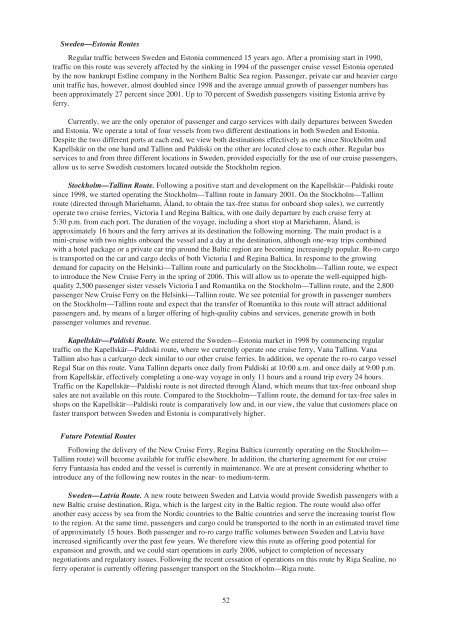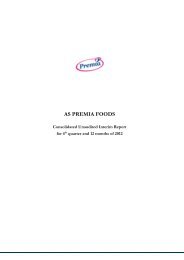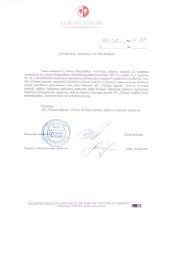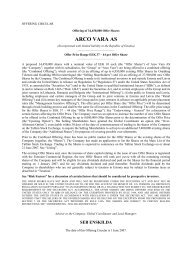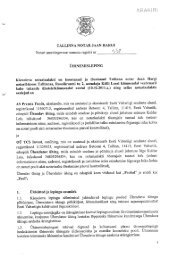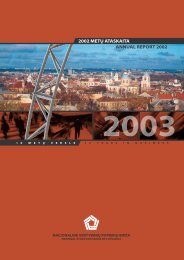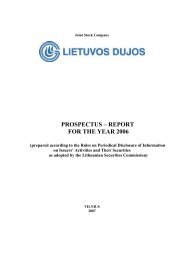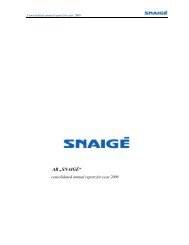Aktsiaselts Tallink Grupp - NASDAQ OMX Baltic
Aktsiaselts Tallink Grupp - NASDAQ OMX Baltic
Aktsiaselts Tallink Grupp - NASDAQ OMX Baltic
Create successful ePaper yourself
Turn your PDF publications into a flip-book with our unique Google optimized e-Paper software.
Sweden—Estonia Routes<br />
Regular traffic between Sweden and Estonia commenced 15 years ago. After a promising start in 1990,<br />
traffic on this route was severely affected by the sinking in 1994 of the passenger cruise vessel Estonia operated<br />
by the now bankrupt Estline company in the Northern <strong>Baltic</strong> Sea region. Passenger, private car and heavier cargo<br />
unit traffic has, however, almost doubled since 1998 and the average annual growth of passenger numbers has<br />
been approximately 27 percent since 2001. Up to 70 percent of Swedish passengers visiting Estonia arrive by<br />
ferry.<br />
Currently, we are the only operator of passenger and cargo services with daily departures between Sweden<br />
and Estonia. We operate a total of four vessels from two different destinations in both Sweden and Estonia.<br />
Despite the two different ports at each end, we view both destinations effectively as one since Stockholm and<br />
Kapellskär on the one hand and Tallinn and Paldiski on the other are located close to each other. Regular bus<br />
services to and from three different locations in Sweden, provided especially for the use of our cruise passengers,<br />
allow us to serve Swedish customers located outside the Stockholm region.<br />
Stockholm—Tallinn Route. Following a positive start and development on the Kapellskär—Paldiski route<br />
since 1998, we started operating the Stockholm—Tallinn route in January 2001. On the Stockholm—Tallinn<br />
route (directed through Mariehamn, Åland, to obtain the tax-free status for onboard shop sales), we currently<br />
operate two cruise ferries, Victoria I and Regina <strong>Baltic</strong>a, with one daily departure by each cruise ferry at<br />
5:30 p.m. from each port. The duration of the voyage, including a short stop at Mariehamn, Åland, is<br />
approximately 16 hours and the ferry arrives at its destination the following morning. The main product is a<br />
mini-cruise with two nights onboard the vessel and a day at the destination, although one-way trips combined<br />
with a hotel package or a private car trip around the <strong>Baltic</strong> region are becoming increasingly popular. Ro-ro cargo<br />
is transported on the car and cargo decks of both Victoria I and Regina <strong>Baltic</strong>a. In response to the growing<br />
demand for capacity on the Helsinki—Tallinn route and particularly on the Stockholm—Tallinn route, we expect<br />
to introduce the New Cruise Ferry in the spring of 2006. This will allow us to operate the well-equipped highquality<br />
2,500 passenger sister vessels Victoria I and Romantika on the Stockholm—Tallinn route, and the 2,800<br />
passenger New Cruise Ferry on the Helsinki—Tallinn route. We see potential for growth in passenger numbers<br />
on the Stockholm—Tallinn route and expect that the transfer of Romantika to this route will attract additional<br />
passengers and, by means of a larger offering of high-quality cabins and services, generate growth in both<br />
passenger volumes and revenue.<br />
Kapellskär—Paldiski Route. We entered the Sweden—Estonia market in 1998 by commencing regular<br />
traffic on the Kapellskär—Paldiski route, where we currently operate one cruise ferry, Vana Tallinn. Vana<br />
Tallinn also has a car/cargo deck similar to our other cruise ferries. In addition, we operate the ro-ro cargo vessel<br />
Regal Star on this route. Vana Tallinn departs once daily from Paldiski at 10:00 a.m. and once daily at 9:00 p.m.<br />
from Kapellskär, effectively completing a one-way voyage in only 11 hours and a round trip every 24 hours.<br />
Traffic on the Kapellskär—Paldiski route is not directed through Åland, which means that tax-free onboard shop<br />
sales are not available on this route. Compared to the Stockholm—Tallinn route, the demand for tax-free sales in<br />
shops on the Kapellskär—Paldiski route is comparatively low and, in our view, the value that customers place on<br />
faster transport between Sweden and Estonia is comparatively higher.<br />
Future Potential Routes<br />
Following the delivery of the New Cruise Ferry, Regina <strong>Baltic</strong>a (currently operating on the Stockholm—<br />
Tallinn route) will become available for traffic elsewhere. In addition, the chartering agreement for our cruise<br />
ferry Fantaasia has ended and the vessel is currently in maintenance. We are at present considering whether to<br />
introduce any of the following new routes in the near- to medium-term.<br />
Sweden—Latvia Route. A new route between Sweden and Latvia would provide Swedish passengers with a<br />
new <strong>Baltic</strong> cruise destination, Riga, which is the largest city in the <strong>Baltic</strong> region. The route would also offer<br />
another easy access by sea from the Nordic countries to the <strong>Baltic</strong> countries and serve the increasing tourist flow<br />
to the region. At the same time, passengers and cargo could be transported to the north in an estimated travel time<br />
of approximately 15 hours. Both passenger and ro-ro cargo traffic volumes between Sweden and Latvia have<br />
increased significantly over the past few years. We therefore view this route as offering good potential for<br />
expansion and growth, and we could start operations in early 2006, subject to completion of necessary<br />
negotiations and regulatory issues. Following the recent cessation of operations on this route by Riga Sealine, no<br />
ferry operator is currently offering passenger transport on the Stockholm—Riga route.<br />
52


